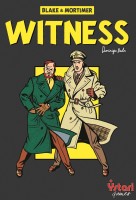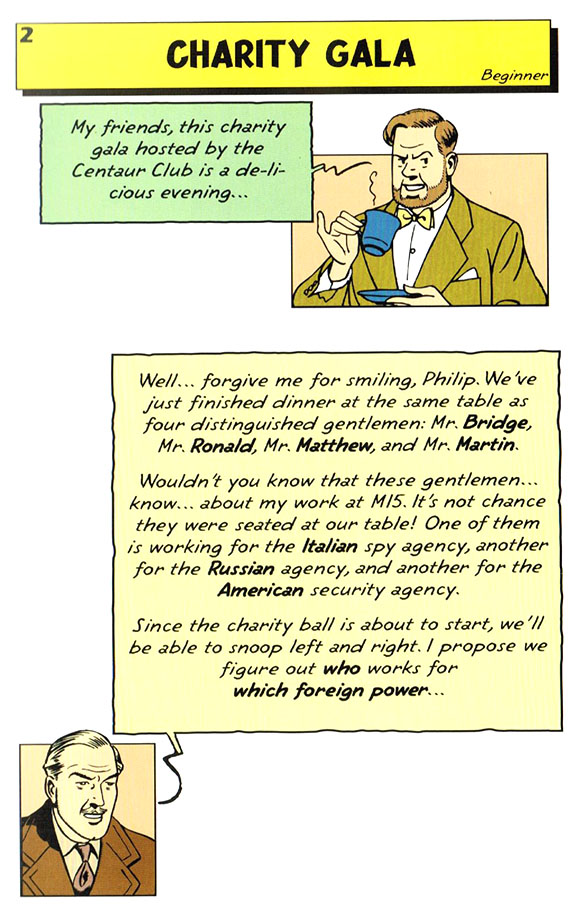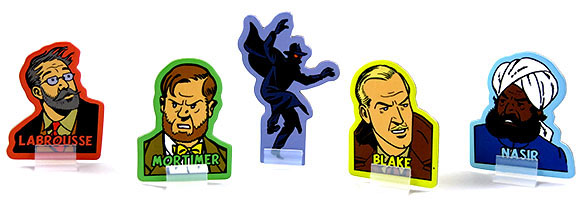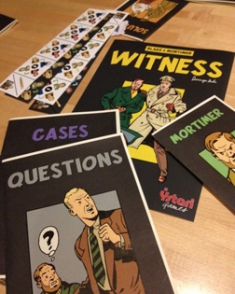
Witness
Overview
Based on the 1940s Belgian Blake & Mortimer pulp comics, Witness tests your deductive reasoning and memory through cooperative clue sharing to solve all manner of sordid crimes. With nice era-appropriate artwork and a real sense of humor, this lightning-quick game should be a winner for anybody looking to think a little (or sometimes a lot) during gaming.
Set Up
Each player will take on one of the game’s four roles: Blake, Mortimer, Nasir and Labrousse. Once characters are assigned, each player receives their character’s clue book and a cardboard standee to place in front of them. There is no board – this standee serves to remind other players who you are.
In the center of the table, one of the two included whisper tiles gets laid out. This tile illustrates which characters are the “whisperers” in each of the 4 game rounds, and which characters receive the whispers. There is a standee (“The Yellow M”) which moves along this tile as the rounds progress – it starts in the first spot.

The players will keep two other books – “Questions” and “Solutions” – near-by. Finally, open the last book (“Cases”) and choose one of Witness‘s 64 included mysteries to read aloud.
All of this takes place in about a minute. As close to a “no-set-up” game as you’ll find.
Gameplay

Once the case has been read, each player will spend a minute or two finding and reading (silently to themselves) the case’s corresponding clue in their clue book. Once committed to memory, your clue book can be set aside (although you can always double-check it – as well as the case itself – if you need to).
Now you’re ready for round one. The Whispers Tile – with the “Yellow M” marker on spot 1 – will illustrate which way the whispers will travel in this round. For instance, it could show that Nasir will be whispering to Blake, while Mortimer will be whispering to Labrousse. You now take these actions – the two whispering characters will need to get out of their seats (unless you’re sitting uncomfortably close to one another) and whisper their clues into the ears of the recipients. In our example, Blake and Labrousse would now hold 2 (different) clues apiece – their own, as well as that of their whisperer. Note that you are NOT allowed to take notes during whispering rounds – you have to commit everything to memory.
The “Yellow M” marker now moves to round 2 of the Whispers Tile, and the responsibilities will rotate. Continuing our example, Blake would now whisper the 2 clues he knows to Mortimer, while Labrousse would whisper the 2 clues he knows to Nasir. Mortimer and Nasir now know 3 clues apiece – their original clue, as well as the 2 clues just whispered to them.
This continues for 2 more rounds, with whispering and listening responsibilities rotating in the same direction until everybody will have heard all 4 clues (and had their original clue whispered back to them).
At the conclusion of the fourth whispering round, each player is given an included note pad to take any notes they wish. These are kept private – players are not allowed to share their notes.
Once everyone is done with their note taking, somebody will open the “Questions” book to the page corresponding to the case being played and read aloud 3 questions. Each player will jot down their answers, which can not be shared with the other players.
Finally, the “Solutions” book is cracked open and the 3 correct answers are read aloud. Each player marks their answers correct or incorrect, and the “correct” answers are totaled. If you’ve attained 12 “correct”s (4 players x 3 questions), you’ve solved the case!
Components

The most important components are the 7 different books (as mentioned above, “Cases”, “Questions”, “Solutions” and a clue book for each character). These books are pretty basic soft-covers, but the paper quality is stout and the illustrations are classic pulp comic fantastic. Each of the 7 books contains 64 pages – one page for each of the included cases.
The game’s 5 cardboard standees (for the 4 characters and the “Yellow M” round marker) aren’t necessary, but certainly don’t hurt in hammering home the game’s plentiful theme. The publishers could have easily had the players keep characters straight by instructing to keep your clue books on the table in front of you, and mark rounds by a wooden cube or glass bead… but these illustrated standees make for a little extra immersion.

The final components are efficient if unremarkable. The Whisper Tiles do their job – they are easy to read (completely symbol-based) and provide a quick reference for where you’re at and what’s to come. And the notepad is just that – sheets of paper with numbered areas to answer each case’s 3 questions.
Learning Curve
We have here a classic in the “easy to learn, hard to master” mold. The rulebook is 2 pages, and it’s unnecessary to even read it (the first case walks you through the rules – in both the Case book and in the character’s clue books).
But while the rules are quite simple, solving the cases is anything but. It will certainly help if you’re a pro at reasoning and possess an elephant’s memory, but the game will provide a challenge to all. The 64 cases come in 4 flavors of difficulty: Beginner (12 cases), Normal (22), Difficult (22) and Diabolical (8).
For example, in our three attempts at the beginner level we were unable to score more than 8 points. And none of our group is particularly dim of wit.
Who would enjoy this game?
Final Thoughts
Please don’t be misled by the somewhat basic nature of the game… Witness is a parade of excitement and fun that rears its head from surprising places.
Even though the clues are only around 10 or 20 words apiece (and sometimes they’re just pictures), they get shockingly hard to remember when you can’t take notes. And the game makes sure each case has several moving pieces. You may be trying to figure out which of 4 individuals is a murder, and which was the victim, but to do so, you’ll have to figure out what kind of mustache each individual wears. You’ll have to keep the 4 suspects’ names straight without writing, and assign to each of them a mustache type.
The most efficient way to pass on information through whispers – particularly in the last couple of rounds – is to consolidate what you’ve learned for ease of remembering. By condensing “A has B, and the person with B did act C” to “A did act C”, you’ll make the clue much easier to remember. But the game can pull the rug out from under you later by telling everyone “the person with B was framed”… and now everyone you passed the clue to is unaware which person “had B”. This clever little game pulls these shenanigans a lot… and it’s hilarious.
On the downside, Witness could suffer some replayability issues if you blast through the cases. While 64 included cases is more than enough if you’re playing 2 cases a week, the game can be quite addicting… and those 64 cases will translate to about 16 hours of play time, so if you run through them in a few weeks you’ll likely remember many of the twist endings. You’re going to have to give yourself time to forget before attempting cases again – and you’ll definitely want to switch roles.
The biggest compliment we can pay to a 15-minute game is that it wraps you up in its theme, and Witness most certainly does. It’s a great little escape.
User Reviews (1)
Add a Review for "Witness"
You must be logged in to add a review.


Everything you need to know is in the fantastic summary and review above, so I’ll only add a few points to stress:
1. This game is about short-term memory and ability to take what you heard and make inductions (come to a conclusion based on putting together separate details) to solve the problem. If you can’t remember anything you heard, or are really bad at induction, then being able to creatively abduct (make something up based on almost no clues) is also a hilarious alternative.
If you or someone in your group can’t accept that most of the game is about hilariously passing on misremembered/misheard clues and trying to make the best guess based on probably very faulty information — to the point of not being able to solve the cases — then you’ll probably find this game more frustrating than fun.
2. If your group can play this game with the mindset that it’s a party game and not a serious deduction game, you’ll all have more fun. Solving the case and winning is incidental to the fun of playing telephone with logic puzzle clues and getting most of them wrong.
If this doesn’t sound like fun, don’t play this.
If you’re hoping for a more straight up crime-solving “deduction” (but really induction) game, then look to something else such as Chronicles of Crime, which is also light, also highly participatory, also requires no note-taking, but takes much longer to search for clues and solve the cases.